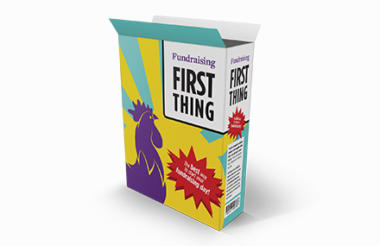More than 40 fundraisers turned out for the latest iteration of Fundraising First Thing, held in London earlier this week.
The topic of the breakfast briefing this month was storytelling. For a number of charities, in particular organisations that work in international development and disaster relief, it can be tempting to use graphic and at times upsetting images and videos of suffering in marketing material to drive public donations. Yet, as the public become increasingly savvy to the pulls and pushes of marketing and less forgiving of organisations trying to exploit ‘disaster porn’, those gathered at FFT were keen to learn where the line is between handling such images sensitively or exploitatively.
Thankfully Mike Thiedke, director of public engagement at Plan International UK, Pamela Jackson, supporter development manager at Médecins Sans Frontiers and Jess Crombie, director of creative content at Save the Children, were on hand to give their expert advice and illuminating case studies. Here’s what we learned.
Ignore your key performance indicators
Plan International UK’s Thiedke kicked off proceedings, with some examples of some successful recent campaigns that his organisation have run on potentially contentious and highly politicised issues, such as female genital mutilation and the taboos around periods.
Thiedke said that the first job of fundraisers, marketers and communicators when dealing with an issue like FGM was to “zoom out of the issue” and to effectively “leave alone your KPIs”. He said that focusing too much on one’s professional expertise will make them miss “where the sensitivities” of the issue lie.
“The fundraisers and communicators were asked to truly zoom out of the issue and leave alone your KPIs and what works for direct marketing and what doesn’t. Leave that alone, think not in the first instance about how you convert people and about how your awareness needs to hit people in the certain peak of the wave of the journey.
“You need to, when it comes to sensitive subjects understand where the sensitives lie and, when you’re too close to your expertise, you won’t see them. Zoom out all of the way, and then drill down a bit and you’ll think about how do awareness, income and influence come together to create change?”
He also warned that utilising graphic images for the sake of it means that donors and the public will “see through you” which can lead to criticism.
“You might think as a fundraiser, going so far back to basics means it’s so generic and you’ve got to hit your targets. That’s right, but in my view if you don’t zoom out you’ll miss the plot. I’ve done that in the past and then you create an asset which is so powerful but all of a sudden you have this social media storm of people literally banging against the wall because you have overlooked some dynamic in the public which will bite you in the bum.”
Thiedke used Plan’s Face Up campaign around FGM, which utilised a number of celebrity ambassadors, public advertising as well as DRTV work. Thiedke said the campaign was hugely successful in terms of engagement, with Plan receiving over 15,000 “cold sign-ups” but admitted he had yet to properly find a way of turning those people into regular givers.
He also suggested that, despite the public advertising campaign, in particular getting full sized ads on the Tube, being “sexy” it was ultimately “very expensive” and something of a waste of time in terms of audience engagement.
Find a ‘sincere and authoritative voice’
Pamela Jackson from MSF urged those in attendance to go back to their organisations and find a “sincere and authoritative voice” when talking about certain issues.
Jackson said that MSF only send one appeal per year to its donor base and give over just about all of their marketing and communications materials to doctors and other professionals out in the field on assignment for the charity around the world. She said that MSF will give these people some training and equipment to help them gather video and blog about their experiences while in the field and that no copywriter, no matter how good, can recreate the stories they tell.
“This is the way that we talk about the work that we do in a very honest and real way. Everything we send out is actually from people who have actually been there so that they have an authentic voice and an authoritative voice because they’re experts in what they’re doing and they’ve actually been to these places and seen what is happening with their own eyes”.
Jackson said that MSF’s “entire approach to fundraising is storytelling”, and pointed to its organisation’s donor magazine Dispatches, and Without Borders, a newspaper insert which it sends out to national and local news organisations every three months or so which has a circulation of around one million copies.
She said that “everything is grounded in first-person stories about medical intervention and, because it’s written by those on the ground, it’s always informative. We also use photography to our advantage and we treat the subjects of those photographs with dignity at all times”.
MSF only send out one appeal per year, said Jackson and don’t “repeatedly ask donors for money or bombard them with other requests”. She said the organisation “avoids hyperbole, dramatisation and overly emotional language” and lets its work “speak for itself”.
She said that, unlike the vast majority of other charities, MSF’s donor base is more than 50 per cent male.
Responsibility to your contributors
In 2015, Save the Children became the first charity to survey the people it used in its marketing and communications material, asking them questions about how they felt sharing their stories not just with the charity but with a wider audience and how they felt these issues would be perceived.
Jess Crombie said the results of this work, which surveyed 202 people including 53 direct contributors and 130 non-contributors, changed the way that STC went about making its material. She said the organisation now does “less shoots, but makes them more in-depth”. She said that while this inevitably made the pieces “more expensive”, it also made them a “more enriching experience for the donors and for those involved”.
Crombie, who prior to working for STC spent 10 years working in advertising, said that charity communicators were effectively “selling stories” to the public and if they don’t get that process right “we don’t really have anything else in our armoury to do what we do. So stories are really integral to Save the Children”.
She said that STC and other charities have a great deal of “power” to share stories of suffering that those on the ground can’t tell themselves. She said that STC now view those who give their time and stories to them to use in marketing material as “partners as opposed to subjects”.
The next Fundraising First Thing event is due to be held 20 March 2018 and will be on incoming EU General Data Protection Regulation coming into force in May.
Related Articles












